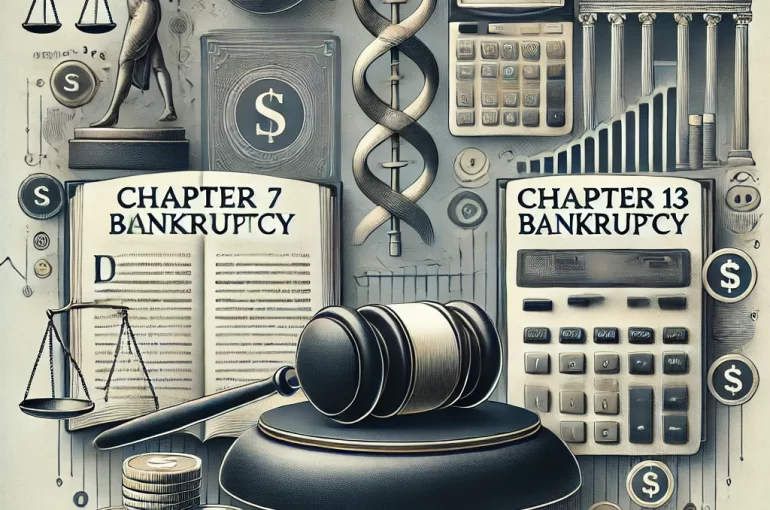Chapter 7 Bankruptcy vs. Chapter 13: What’s the Difference?
Introduction
Filing for bankruptcy can be a difficult decision, and understanding the differences between Chapter 7 and Chapter 13 bankruptcy is essential for making an informed choice. Each type of bankruptcy serves different needs and offers distinct benefits and drawbacks. This guide will help you understand the key differences between Chapter 7 and Chapter 13 bankruptcy, so you can choose the option that best suits your financial situation.
What is Chapter 7 Bankruptcy?
Chapter 7 bankruptcy, often referred to as “liquidation bankruptcy,” allows individuals to discharge most of their unsecured debts. It is typically the preferred option for those with low income and few assets. In a Chapter 7 bankruptcy, a trustee is appointed to oversee the sale of non-exempt assets, and the proceeds are used to repay creditors.
Key Features of Chapter 7 Bankruptcy:
- Eligibility: Income must be below a certain threshold, determined by the means test.
- Asset Liquidation: Non-exempt assets may be sold to repay creditors, but most essential property is usually protected.
- Debt Discharge: Most unsecured debts, such as credit card debt and medical bills, can be discharged, eliminating the legal obligation to pay them.
- Timeline: The process typically takes 3-6 months from filing to discharge.
What is Chapter 13 Bankruptcy?
Chapter 13 bankruptcy, also known as a “wage earner’s plan,” allows individuals with regular income to create a repayment plan to pay off their debts over a period of 3 to 5 years. This option is ideal for those who have a steady income but need time to catch up on missed payments or want to keep their property, such as a home or car, that might be at risk in a Chapter 7 filing.
Key Features of Chapter 13 Bankruptcy:
- Eligibility: Available to individuals with a stable income and unsecured debts below $465,275 and secured debts below $1,395,875 (as of 2020).
- Repayment Plan: Debtors propose a repayment plan to pay back all or part of their debts over 3-5 years.
- Asset Protection: Allows debtors to keep their property, such as a house or car, by catching up on missed payments through the repayment plan.
- Debt Discharge: Any remaining unsecured debt may be discharged at the end of the repayment plan, providing a fresh start.
Key Differences Between Chapter 7 and Chapter 13 Bankruptcy
While both Chapter 7 and Chapter 13 bankruptcy can provide relief from overwhelming debt, they serve different purposes and have distinct requirements:
- Eligibility: Chapter 7 is based on income and is designed for those who cannot afford to pay back their debts. Chapter 13 is for individuals with regular income who can afford to repay some or all of their debts.
- Debt Repayment: Chapter 7 involves liquidating assets to pay creditors, while Chapter 13 involves a structured repayment plan over several years.
- Asset Protection: Chapter 13 allows debtors to keep their assets if they follow the repayment plan, whereas Chapter 7 may require the sale of non-exempt assets.
- Impact on Credit: Both types of bankruptcy affect your credit, but Chapter 7 remains on your credit report for 10 years, while Chapter 13 remains for 7 years.
- Timeframe: Chapter 7 is generally quicker, often taking 3-6 months, while Chapter 13 requires a longer commitment of 3-5 years.
Which Option is Right for You?
The choice between Chapter 7 and Chapter 13 bankruptcy depends on your specific financial situation. Chapter 7 may be the best option if you have little to no income and few assets, and you need a quick way to eliminate most of your debts. On the other hand, Chapter 13 might be more suitable if you have a steady income, valuable assets you want to protect, or you need time to catch up on missed mortgage or car payments.
It’s crucial to consult with an experienced bankruptcy attorney to evaluate your options and determine which type of bankruptcy is the best fit for your circumstances. If you’re considering filing for bankruptcy in Dallas, [Engel Law Group](https://www.engellawgroup.com/bankruptcy/chapter-7-bankruptcy/) offers comprehensive legal advice and guidance to help you navigate the process and make informed decisions.
Conclusion
Understanding the differences between Chapter 7 and Chapter 13 bankruptcy is essential for anyone considering this financial option. While both can provide relief from debt, they are designed for different situations and have distinct requirements and outcomes. By consulting with a knowledgeable attorney and carefully assessing your financial situation, you can choose the path that offers the best chance for a fresh financial start.
If you’re struggling with debt and are considering bankruptcy in Dallas, contact [Engel Law Group](https://www.engellawgroup.com/bankruptcy/chapter-7-bankruptcy/) for a consultation to explore your options and take the first step toward financial freedom.


Leave a Reply